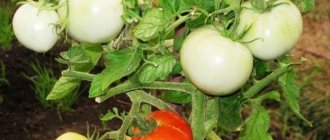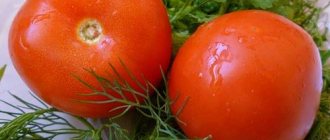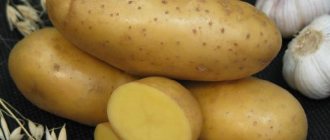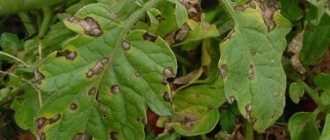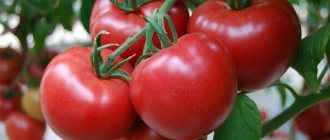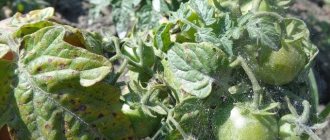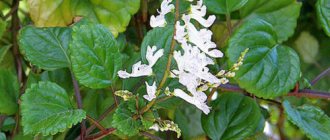Features of Volgograd tomato
According to the characteristics and description, tomatoes of the Volgogradsky variety reach full ripeness approximately on the 100th day after the formation of the first leaves, therefore the species is classified as mid-season. The maximum height of this determinate bush does not exceed 1 meter.
Features of Volgograd tomato
Despite its small size, the Volgograd tomato is distinguished by a large number of peduncles. On the shoots of the plant there is a thick layer of dark green round leaves. At the bottom of each leaf there is an ovary - from 5 to 7 round tomatoes on one bunch. The fruits, evenly distributed throughout the bush, ripen at the same time and have approximately the same weight, fleshy sweet pulp and dense skin that protects from mechanical damage.
Due to its low growth and massive shoots, the bush does not need staking. The exception is planting areas with strong gusty winds and drafts.
general information
Tomatoes of the Volgograd selection are very similar to each other, but they still have some differences. The height of the bush, the size and color of the fruit, and the ripening time are slightly different from each other. Many people like Volgograd tomatoes. The characteristics and descriptions of the varieties allow us to tell those who planted them that they still have not lost their relevance and attractiveness.
A common feature of this selection is a compact bush that does not require support or removal of stepsons. It itself regulates pore formation and the number of fruits it can feed.
Small but pleasant-tasting fruits are also the basis of the variety. Volgogradsky 595 tomatoes have slightly larger tomatoes than the other two varieties, but they taste very similar.
Another very important feature of this selection is resistance to certain diseases. Not many hybrids, much less varieties, are able to resist fusarium and verticillium. And this is another plus to their advantages.
Volgograd tomatoes, a description of the cultivation of different varieties of this selection is presented in detail in this article, will allow gardeners to decide which variety is preferable to grow in their dacha or garden.
Subspecies
There are several subspecies of the Volgograd tomato. Each of them has different agricultural technology features, which are important to study before planting bushes on the site.
Volgogradsky 5/95
Tomato Volgogradsky 5/95 is valued for its good yield and active fruiting. Suitable for cultivation in both greenhouses and open ground. This is an indeterminate plant of small size, with rich green foliage and round, orange-red, sweet and sour tomatoes containing 5-6 seed chambers. The mass of each is 120 g. In open ground conditions, the yield of one shrub reaches up to 3 kg (when placing 3 specimens per 1 m2). In greenhouses this figure increases by 25%. The fruits become completely ripe in 110-120 days.
Tomato Volgogradsky 5/95
The southern regions are considered optimal conditions for the Volgogradsky 5/95 tomato, where the highest yield is observed (8 kg). In the middle climate, it is recommended to use a special film covering, and in the northern regions, normal plant development is possible only in a greenhouse. At the same time, the richness of the taste of tomatoes noticeably deteriorates.
Tomatoes of the Volgogradsky 5/95 variety are famous for their long shelf life and can easily be transported even over long distances. The fruits have universal uses: tomatoes are eaten fresh, added to dishes, and used for juices and sauces. At the same time, neither preservation nor heat treatment weakens the rich-sweet taste.
Volgograd early ripening 323
Based on the characteristics and descriptions, the Volgograd early ripening tomato variety was bred more than 30 years ago as a hybrid subspecies. The maximum height of the plant is 50 cm; the bush does not need tying. Has average immunity to fungal infections
Tomato Volgograd early ripening 323
The Volgograd early ripening tomato 323 is distinguished by its fleshy fruits with a rich taste, which ripen on the 100th day from the moment of moving to open ground. Tomatoes are easily recognized by their bright scarlet color and symmetrical round shape. Productivity - 7 kg per 1 m2. Like other varieties of Volgograd tomatoes, Skorospelyi has many uses: excellent for fresh consumption, use in dishes, for pickling, marinade and canning, making juice, paste, ketchup, etc.
Volgograd pink
The Volgograd pink tomato is a low-growing, early-ripening variety with a high level of fruiting. Tomatoes ripen on the 100-105th day from the moment the first stems appear. This is a fairly compact plant, not exceeding 50-55 cm in height. The variety has medium-sized leaves, dark green in color. Tomatoes weighing up to 100 g are round-flat, with a bright sweet and sour taste. This hybrid is in many ways similar to the Volgogradsky 323 tomato: the difference between the varieties is only in color and taste.
Volgograd pink tomato
Tomatoes are also versatile in use, well suited for both cooking and canning. The juice is rich in taste, with a pinkish tint.
The variety is characterized by long shelf life and high resistance to transportation, and is immune to fungal infections.
Disease resistance
Since the Volgograd tomato was bred quite a long time ago and has not changed much since then, it does not have high resistance to various nightshade diseases. It is necessary to work proactively and do everything possible to prevent the disease. Otherwise, the gardener may be left with a meager harvest or no harvest at all.
The Volgograd tomato variety is especially often sick:
- Late blight - damage to shoots, leaves or fruits by late blight fungi. Their spores are found in the soil and do not die even during the harshest winters. Seeds of the Volgograd tomato variety may also be infected. For prevention, bushes and the ground around them are treated with copper sulfate or other specialized preparations. Fruits and plants affected by late blight are immediately removed, but not thrown away. Fungal spores remain active for a long time. They must be burned.
- Alternaria blight is a bacterial disease that is provoked by a violation of crop rotation and growing conditions of the Volgogradsky tomato variety. The crop is affected by spotting and eventually withers along with the unripe fruits. For prevention purposes, Bordeaux mixture and copper oxychloride are used. Already affected specimens are sprayed with Ridomil.
- Anthracnose is an infectious disease of the Volgogradsky tomato variety. The pathogen enters the soil with contaminated seeds or fertilizers. The disease manifests itself as damage to ripe fruits by speckled rot. Diseased bushes must be disposed of in a timely manner by moving them away from the site or by burning them.
Using modern breeding methods, subspecies have been bred that have greater resistance to dangerous diseases. Tomato Volgogradsky - 323 is an early pink variety, much more resistant to late blight, but tomato Volgogradsky - 595 is a later variety and is not susceptible to anthracnose.
Recommendations for growing the variety
The Volgograd tomato is one of the most undemanding varieties. Knowledge of some features of agricultural technology will allow you to grow an abundant and tasty harvest on your site.
Seed
The period of planting Volgograd tomato seedlings lasts from February to April. Seeds of tall subspecies must be planted in February, and low-growing ones - in March.
It is important to calculate the time correctly: with very early planting, a lack of light and a long stay in a cramped container will negatively affect the development of plants.
Tomato seeds
Sequencing:
- Before sowing into the ground, seeds must be sorted and those that are too small or damaged must be eliminated.
- To increase germination, leave the planting material in a manganese solution for 25-30 minutes.
- The nutritious soil required for planting can be purchased at a garden center or mixed independently from peat, humus and turf soil in equal proportions. Then pass the resulting substrate through a sieve and compact it tightly into the container.
- Place the seeds in the soil to a depth of 3-5 cm, at a distance of 3-4 cm.
- Spray the soil with a garden sprayer and cover the containers with film on top. The room temperature should be no less than 10 and no more than 20 oC.
When the first few leaves appear, the seedlings can be moved to larger containers for the growth of the root system.
Seedling
The seedling method is the most common for the Volgograd tomato:
- To obtain a healthy and abundant harvest, it is important to prepare the planting site in advance, in late autumn. Dig up the soil, then fertilize it with humus and mineral complexes. In spring, dig up the soil again, this time with the addition of ammonium nitrate.
- Plant seedlings in deep enough holes to ensure normal development of the root system.
- Fill the seedlings up to the first leaves. It is not advisable to fill the hole completely with soil: it will be enough to dig it halfway for ease of watering.
Tomato seedlings
After 2-3 days, the seedlings will begin to reach for sunlight: on especially hot days they need additional protection from direct rays to avoid burns.
Features of cultivation, planting and care
sowing the seeds of this tomato variety for seedlings 55-60 days before the intended planting in the ground. Seedlings dive at the stage of 2 true leaves. When planting seedlings in a permanent place per 1 sq. Place 6-8 plants per meter of plot. Planting pattern: 70 x 30 - 40 cm.
Caring for tomatoes after planting consists of timely watering, removing weeds, fertilizing with complex mineral fertilizer and preventive measures to protect tomatoes from pests and diseases.
We remind you that to obtain the most delicious and aromatic fruits of any variety, tomatoes need loose, humus-rich soil, moderate watering, maximum sun and an optimal number of healthy leaves.
This is a natural variety of tomato. Therefore, we recommend taking seeds from a ripe fruit and using them for planting in subsequent seasons.
Tips for further care
The Volgograd tomato reacts negatively to excess moisture, so excessive watering is contraindicated. In normal weather, it is enough to irrigate the bush once every 10-14 days. During dry periods, increase the frequency of watering. An effective way to control the required volume of water supply: if the soil remains moist in a depression of up to 10 cm, there is no need to irrigate the soil.
You can use compost and rotted manure to feed the soil. This helps increase productivity up to 8 kg per 1 m2.
Another advantage of the Volgograd tomato is that it does not require pinching. Thanks to the distribution of foliage, sunlight falls evenly on all parts of the plant and the tomatoes themselves. At the same time, some gardeners still use pinching in order to reduce the yield of shrubs or increase the weight of fruits. In addition, removed stepsons can be useful as fertilizer:
- Fill them with plain water and leave to soak for several weeks.
- After fermentation begins, strain thoroughly.
- Dilute with water in a ratio of 1/10.
Apply the prepared fertilizer while watering the bush, right under the root.
How to grow seedlings
For Volgograd early ripening 323, the seedling method of cultivation is preferable, although direct sowing in the ground is also allowed in the southern regions after the May holidays. Depending on climatic conditions, the summer resident himself decides where he will grow tomatoes - in open or protected ground.
Seed preparation
The seeds of the variety have almost 100% germination and do not require special pre-sowing preparation. You can speed up the germination process by soaking it in a gauze cloth moistened with a weak solution of potassium permanganate for 24 hours.
Container and soil
Any low and wide containers that you have on hand are suitable for sowing.
Tomatoes are demanding on fertility and water-air exchange in the soil. You can buy the substrate for sowing ready-made or prepare it yourself:
- peat - 1 bucket;
- humus - 2 buckets;
- sand - 0.5 buckets.
Add 1 tsp to this mixture. superphosphate, 1 tsp. potassium sulfate and a third of a bucket of wood ash. This soil is slightly acidic in composition, rich in mineral compounds and organic matter, and has good air permeability.
Attention ! Before sowing seeds, the soil needs preventive treatment. The best treatment method is watering with a strong solution of potassium permanganate or biological preparations Fitosporin-M or Trichodermin.
Sowing
Prepared seeds are sown in containers filled with moist soil to a depth of 1.5 cm, the distance between plants is 2-4 cm, between rows - 2 cm. The crops are covered with the same fertile soil and moistened again. The boxes are covered with film to create a greenhouse effect.
Optimal conditions for seed germination:
- temperature 22-25 °C;
- humidity 75%.
The timing of sowing seeds depends on the location of further cultivation of tomatoes:
- for heated greenhouses - February;
- for film greenhouses and greenhouses - the third ten days of March;
- in open ground - 1-2 weeks of April.
Growing and care
As soon as the shoots appear (after 4-5 days), the young seedlings are freed from the film and placed in a well-lit place. Watering should be regular. Seedlings that have not shed their cotyledon leaves are plucked off by hand.
Temperature for normal development of seedlings:
- daytime - 15-20 °C;
- night - 8-12 °C.
Like adult tomatoes, seedlings are fed. Fertilizing with complex mineral fertilizers once every 2 weeks (Kemira Lux, Mortar A) has worked well.
2 weeks before planting, the seedlings are hardened off. If tomatoes are grown in apartment conditions, then arrange through ventilation of the room. If possible, the plants are taken out onto the balcony. When the seedlings reach a height of 15-20 cm, they are planted in open ground.
Important ! If the seedlings have stretched out, they can be saved by picking them into tall glasses with the root collar buried.
What do the fruits look like?
Volgograd tomatoes can be recognized by their round shape and light ribbing on the surface. At first, light green fruits appear, which become rich red as they ripen. On average, each weighs from 70 to 90 g. Tomatoes are quite dense, with fleshy juicy pulp and a bright tomato taste, characterized by a characteristic sourness.
The fruits are universal in use. Due to the rich amount of microelements in the composition, they are especially useful for fresh consumption. More mature tomatoes are great for various dishes, pasta, ketchup, and juice. The thick skin retains its shape well, so the tomatoes do not crack and are convenient to use for preservation.
Description of the variety “Volgograd early ripening 595”
Tomato Volgogradsky 595, determinate, low-growing variety. The time period from germination to fruit appearance is only 110-112 days. The height of the bush reaches 70 cm. The leaves are not very large. The first brush is tied after 6-7 leaves.
Description of fruits
The fruits of the Volgogradsky 595 tomato are red-orange in color, round-flat in shape, weighing 80-160 g. With good care, timely feeding and removal of excess shoots, their weight reaches 150-260 g. The fruits have 6-8 chambers. The taste of tomatoes is close to traditional, but there is some sugar content.
Purpose of the variety
This variety is universal. Due to its taste, it is used both fresh and for processing. The juice from tomato fruits of this variety is very tasty.
It has a sweetish taste with a piquant sourness, giving it freshness and richness.
Photos of subspecies of the Volgograd variety
Tomato Volgogradsky 5/95
Tomato Volgograd early ripening 323
How tomatoes are used
Tomatoes come in almost the same shape and size - 75-100 g, so they are successfully rolled into jars for the winter. This is facilitated by the thick skin. It is not harsh and is not noticeable in salads. The rich sweet taste of the pulp improves not only the taste of salads, but also soups, borscht and gravy for main courses. The Volgograd tomato is used for making purees, pastes, juice and baby food.
Harvest and storage
Harvesting begins when the fruits have acquired the characteristic color of the variety and are ripe. Vegetables can be picked from the bush even slightly unripe: they ripen perfectly on their own, while the taste does not change at all. It is recommended to collect tomatoes before the cool of the evening or early in the morning to avoid dew. It is worth picking them with the stalk, since if it is present, the fruits are stored better.
If the weather is dry or excessively hot, the “Volgograd” variety does not pigment the fruits actively enough, so it takes longer for them to turn red. You can remove the tomatoes from the branch, but it would be wise to wait a few days for the tomato to ripen and be saturated with plenty of vitamins.
Picked tomatoes are stored in wooden or plastic containers, in which the vegetables are placed in rows with the stalk facing up. The maximum number of rows is 3. The storage room should be cool and dark (refrigerator, cellar, basement). Comfortable storage temperature is +5–12 °C at a relative air humidity of 80%.
For storage, fruits with whole skin and no damage are sorted. Tomatoes that have reached milky maturity (turned brown) and have acquired the size characteristic of the variety are perfect. You should periodically check containers and discard vegetables that begin to spoil.
Protection from diseases and pests
Despite its excellent immunity, the variety is susceptible to a number of ailments, including:
| Disease | Symptoms | Prevention | Treatment |
| Late blight | Irregular brown spots on the stem, falling inflorescences, dry leaves, grey-brown/black spots on the fruits. |
|
|
| Powdery mildew | Powdery coating on the surface, the plant becomes deformed and dries out, the flowers become covered with white fluff and cracks. | Treating seeds with potassium permanganate before planting, maintaining crop rotation, regular ventilation of greenhouses, correct watering and fertilizing. |
|
| Verticillium | During the flowering phase, the lower leaves begin to turn yellow, as a result of which they wither and fall off. The upper ones remain green, but are noticeably deformed. | Treat with a solution of wood ash and laundry soap, spray with potassium permanganate mixed with boric acid, and avoid waterlogging the soil. | Infected specimens cannot be treated and must be disposed of by fire. |
| Cladosporiosis | Brown spots on the underside of leaf blades, mainly the lower ones. As a result, the bush begins to wither and dies. | Plant residues are regularly removed, treated with Bordeaux mixture several times a season, and moisture does not stagnate during watering. |
|
In the event of insects such as whiteflies or spider mites, the green mass is sprayed with any insecticide, among which Actellik has proven itself well. A concentrated solution of laundry soap will help get rid of aphid colonies.
Pros and cons of the variety
- The advantages of Volgograd tomatoes include:
- excellent tolerance to temperature changes (day/night, cold snaps, droughts, etc.);
- possibility of growing in open ground, greenhouse, greenhouse;
- ease of care;
- a small set of leaves allows the fruits to be evenly illuminated by sunlight;
- stable yield;
- uniform ripening of tomatoes;
- the same size of all tomatoes on the bush;
- high taste qualities of the fruit;
- excellent presentation;
- suitability for long-term storage;
- tolerates transportation well;
- versatility of use without loss of taste;
- resistance to characteristic diseases and pests.
Based on reviews from gardeners, it can be argued that “Volgogradsky” is practically free of shortcomings. Some note only that the seedlings are intolerant of excess moisture, so you should be more careful about watering.
Reviews about the variety
Vladimir, 49 years old, Ufa.
I live in an apartment, but I have my own summer cottage. I can't live without fresh vegetables. I buy seedlings. I recognize the Volgograd ones by their appearance. They have thick and hairy stems and leaves. Everyone always gets along. And the taste of the fruit is unsurpassed. This is a classic.
Elena, 63, Murmansk.
I love plants, so herbs, spices and whatever thrives in such conditions always grow on the balcony. When I found out about Volgograd tomatoes and tasted them, I decided to buy a summer cottage. Now I spend the whole summer away from the city, caring for my favorite variety. I collect a lot, so I preserve them for the winter; they lend themselves well to heat treatment.
If you want to grow a truly early variety of tomatoes in your own garden, then you should choose Volgograd tomatoes. This variety has a large number of positive characteristics that make it possible to get fruits in the early stages. In this case, you do not have to put a lot of effort into growing the crop.
